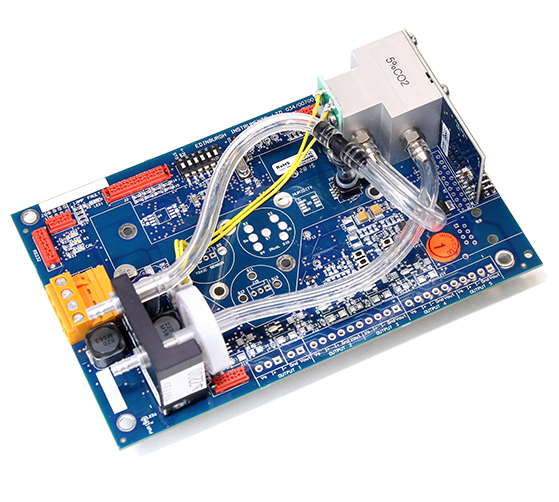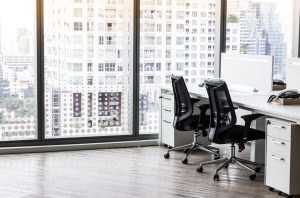What is Sick Building Syndrome?
Sick building syndrome (SBS) is a medical condition where people, who work or live in the same building, suffer a variety of symptoms of illness and feel unwell, for seemingly no apparent reason. Common sick building syndrome symptoms include eye irritation, headaches and shortness of breath. Typically, all of these symptoms are alleviated as soon as the sufferer leaves the building or room in question.1
While the exact underlying causes of sick building syndrome are difficult to isolate and identify2, it is clear that good building ventilation improves symptoms and that high carbon dioxide levels have a role to play.3,4 Adequate ventilation also reduces the impact of other contributing factors to sick building syndrome, such as high volatile organic compound (VOC) concentrations that may arise from degassing of furniture and floor linings.5
In a building afflicted with sick building syndrome, nearly all occupants may be affected3,4 with detrimental effects on their well being and productivity. Normally, symptoms disappear as soon as the sufferer leaves the building, but as any possible long-term effects are yet unknown, precautions should be ensure prevention of sick building syndrome.6

Sick Building Syndrome Prevention
The Health and Safety Executive advice for sick building syndrome prevention at the workplace focuses on a range of strategies for preventing sick building syndrome, including improving lighting, ensuring spaces are well-ventilated and that ventilation systems are also well maintained.7 They also mention one of the challenges of diagnosing sick building syndrome is that polluting chemicals and gases may be ‘present at several times lower than the current occupational exposure limits’ and therefore that ‘sampling may be complex’.
For carbon dioxide, which has been implicated in causing SBS3,4, current 8-hour time-weight average exposure limits are 5000 ppm.8 The National Institute for Occupational Health and Safety states that carbon dioxide levels exceeding 40 000 ppm (4 %) pose an immediate risk to health and life.9 The American Society of Heating, Refrigeration and Air Condition Engineers also recommend keeping carbon dioxide concentrations around 1000 ppm for optimum comfort in the workplace.10
Monitoring carbon dioxide levels is an important part of managing sick building syndrome and requires continual, online gas analysis with highly sensitive detectors as sub-1000 ppm concentrations of carbon dioxide have been reported in a major case of SBS.3,4 For this, Edinburgh Sensors offers a series of online gas monitors with easy installation, suitable for use in working buildings or while they are being constructed.11
Gas Monitoring for Ventilation Systems
Edinburgh Sensors have over twenty years of expertise in non-dispersive infrared (NDIR) gas monitors for a variety of applications.12 As well as being failsafe and easy to use for continual monitoring, NDIR sensors offer highly sensitive detection for gases such as CO2. This is because gases such as methane and carbon dioxide absorb infrared light very strongly and have characteristic fingerprint signals for unambiguous identification so even trace amounts of gases can be detected.
The Gascard NG technology13 is already being used as part of integrated centrally-controlled ventilation systems for the monitoring and management of sick building syndrome. The Gascard can provide fast and reliable CO2 concentration measurements in the range of 0 – 5000 ppm and the RS232 connections and ability to connect by USB for data logging means it is easy to work into integrated early-warning and detection systems.
As well as the convenient Gascard NG, which has a relatively low power draw and small footprint, Edinburgh Sensors offers the Boxed Gascard.14 This contains the same Gascard NG technology but the convenient housing means that it can be installed straight away. The Boxed Gascard also offers excellent accuracy (±2% of range) over 0 – 45◦C and 0 – 95 % humidity meaning measurements can be relied upon no matter what the environmental conditions.

One possibility with the Gascard is to integrate the CO2 sensing capabilities with feedback loops for the ventilation system of a building. Improving ventilation speeds and maintaining adequate ventilation levels is key in reducing the symptoms associated with sick building syndrome and improving working comfort. If CO2 levels begin to rise, which can be easily detected by the Gascard, this information could then be used to change ventilation conditions before a problem ever arises.
Other Options for Sick Building Syndrome Prevention
The GuardianNG series are capable of detecting CO2 concentrations between 0 – 3000 ppm, with a response time of less than 30 seconds from the sample inlet to detection.15 Designed as a simple, easy to mount box unit, the Guardian NG also comes with a graphical display that gives a true volume percentage readout that is pressure compensated and can show historical data logs. Where remote monitoring or logging of gas concentrations is desirable, there is an onboard RS232 interface or optional Ethernet for connection to remote networks.
The GuardianNG has a built-in alarm system, with user-controlled alarm points but can be easily connected with other integrated safety systems. If the device is to be left in an accessible area, password protection can be implemented to prevent accidental or deliberate change of settings, so the device can always be relied upon.
With the highly accurate (≤ 2% of full scale) sensor and capability to measure in conditions between 0 – 95 % humidity, the Guardian NG is a robust and ideal solution for discrete installation and monitoring in office, residential or industrial buildings. The IP54 enclose also helps prevent any build-ups of particulates or water that may interfere with measurements.
For all users, purchase of the Guardian NG comes with one-to-one technical support and customer service throughout the process, from purchase to final device installation.
Additional options include the GasCheck16 and IRgasKiT17 each with their unique strengths. If you are looking for a reliable, robust device with the excellent sensitivity required to help prevent SBS syndrome, then Edinburgh Sensors customer service can help you find the device to meet your needs.
Can Sick Building Syndrome be prevented?
To help decrease your own risk of Sick Building Syndrome, here are a few tips to prevent SBS:
- Getting yourself out of the building as much as possible; eating lunch outside or walking on your break
- Allowing fresh air into the building by opening windows
- Stepping away from your computer; stretching your legs and giving your eyes a break from the screen

Are you looking for help with Sick Building Syndrome Prevention?
If you are interested in sick building syndrome prevention and would like to find out more more or learn about our products, please do not hesitate to contact us today. Alternatively, if you have found this article interesting and would like to read further news and research from Edinburgh Sensors, why not sign up to our infrequent eNewsletter below and join us on social media.
References
- WHO on Sick Building Syndrome, https://www.wondermakers.com/Portals/0/docs/Sick%20building%20syndrome%20by%20WHO.pdf, (accessed March 2019)
- Canadian Health Report, https://irp-cdn.multiscreensite.com/c4e267ab/files/uploaded/1guWHz7oRTeLGl6eSyjV_Canada_Indoor%20Air%20Quality%20in%20Office%20Buildings_A%20Technical%20Guide_1995.pdf, (accessed March 2019)
- Wang, J. Li and C. Zhao, Proc. Indoor Air 2002, 2002, 490–493.
- Erdmann, K. Steiner and M. Apte, Proc. Indoor Air 2002, 2002, 443–448.
- VOCs in SBS, https://iaqscience.lbl.gov/voc-summary, (accessed March 2019)
- Luiz, D. M. Rios, J. Laerte, A. Gioda, C. Yara, F. Radler, D. A. Neto and J. Roberto, Environ. Int., 2009, 35, 1136–1141.
- HSE on SBS, http://www.hse.gov.uk/pubns/priced/hsg132.pdf, (accessed March 2019)
- HSE on Carbon Dioxide, http://www.hse.gov.uk/carboncapture/carbondioxide.htm, (accessed March 2019)
- NIOSH Guidelines, https://www.cdc.gov/niosh/docs/76-194/default.html, (accessed March 2019)
- ASHRAE CO2 Guidelines, https://www.ashrae.org/File%20Library/Technical%20Resources/Technical%20FAQs/TC-04.03-FAQ-35.pdf, (accessed March 2019)
- Gas Monitors Catalogue, https://edinburghsensors.com/products/gas-monitors/, (accessed March 2019)
- About Edinburgh Sensors, https://edinburghsensors.com/about/about-us/, (accessed March 2019)
- Gascard NG, https://edinburghsensors.com/products/oem/gascard-ng/, (accessed March 2019)
- Boxed GasCard, https://edinburghsensors.com/products/oem/boxed-gascard/, (accessed March 2019)
- Guardian NG, https://edinburghsensors.com/products/gas-monitors/guardian-ng/, (accessed March 2019)
- Gascheck, https://edinburghsensors.com/products/oem/gascheck/, (accessed March 2019)
- IRGasKit, https://edinburghsensors.com/products/oem/irgaskit/, (accessed March 2019)

